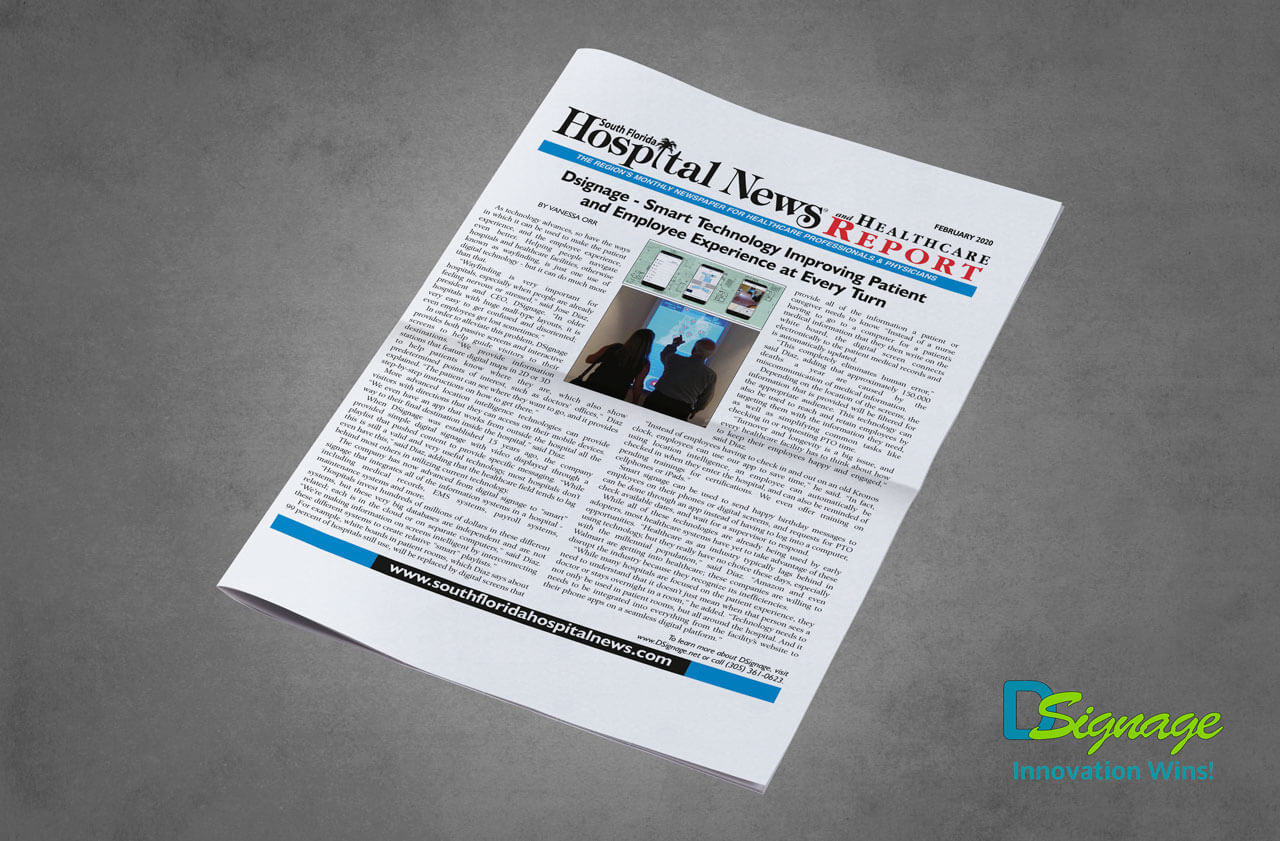
As technology advances, so have the ways in which it can be used to make the patient experience, and the employee experience, even better. Helping people navigate hospitals and healthcare facilities, otherwise known as wayfinding, is just one use of digital technology – but it can do much more than that.
“Wayfinding is very important for hospitals, especially when people are already feeling nervous or stressed,” said Jose Diaz, president and CEO, DSignage. “In older hospitals with huge mall-type layouts, it is very easy to get confused and disoriented; even employees get lost sometimes.”
In order to alleviate this problem, DSignage provides both passive screens and interactive screens to help guide visitors to their destinations. “We provide information stations that feature digital maps in 2D or 3D to help patients know where they are, which also show predetermined points of interest, such as doctors’ offices,” Diaz explained. “The patient can see where they want to go, and it provides step-by-step instructions on how to get there.”
More advanced location intelligence technologies can provide visitors with directions that they can access on their mobile devices. “We even have an app that works from outside the hospital all the way to their final destination inside the hospital,” said Diaz.
When DSignage was established 15 years ago, the company provided simple digital signage with video displayed through a playlist that pushed content to provide specific messaging. “While this is still a valid and very useful technology, most hospitals don’t even have this,” said Diaz, adding that the healthcare field tends to lag behind most others in utilizing current technology.
The company has now advanced from digital signage to “smart” signage that integrates all of the information systems in a hospital – including medical records, EMS systems, payroll systems, maintenance systems and more.
“Hospitals invest hundreds of millions of dollars in these different systems, but these very big databases are independent and are not related; each is in the cloud or on separate computers,” said Diaz. “We’re making information on screens intelligent by interconnecting these different systems to create relative “smart” playlists.”
For example, white boards in patient rooms, which Diaz says about 99 percent of hospitals still use, will be replaced by digital screens that provide all of the information a patient or caregiver needs to know. “Instead of a nurse having to go to a computer for a patient’s medical information that they then write on the white board, the digital screen connects electronically to the patient medical records and is automatically updated.
“This completely eliminates human error,” said Diaz, adding that approximately 150,000 deaths a year are caused by the miscommunication of medical information.
Depending on the location of the screens, the information that is provided will be filtered for the appropriate audience. This technology can also be used to reach and retain employees by targeting them with the information they need, as well as simplifying common tasks like checking in or requesting PTO time.
“Turnover and longevity is a big issue, and every healthcare facility has to think about how to keep their employees happy and engaged,” said Diaz.
“Instead of employees having to check in and out on an old Kronos clock, employees can use our app to save time,” he said. “In fact, using location intelligence, an employee can automatically be checked in when they enter the hospital, and can also be reminded of pending trainings for certifications. We even offer training on cellphones or iPads.”
Smart signage can be used to send happy birthday messages to employees on their phones or digital screens, and requests for PTO can be done through an app instead of having to log into a computer, check available dates, and wait for a supervisor to respond.
While all of these technologies are already being used by early adopters, most healthcare systems have yet to take advantage of these opportunities. “Healthcare as an industry typically lags behind in using technology, but they really have no choice these days, especially with the millennial population,” said Diaz. “Amazon and even Walmart are getting into healthcare; these companies are willing to disrupt the industry because they recognize its inefficiencies.
“While many hospitals are focused on the patient experience, they need to understand that it doesn’t just mean when that person sees a doctor or stays overnight in a room,” he added. “Technology needs to not only be used in patient rooms, but all around the hospital. And it needs to be integrated into everything from the facility’s website to their phone apps on a seamless digital platform.”

